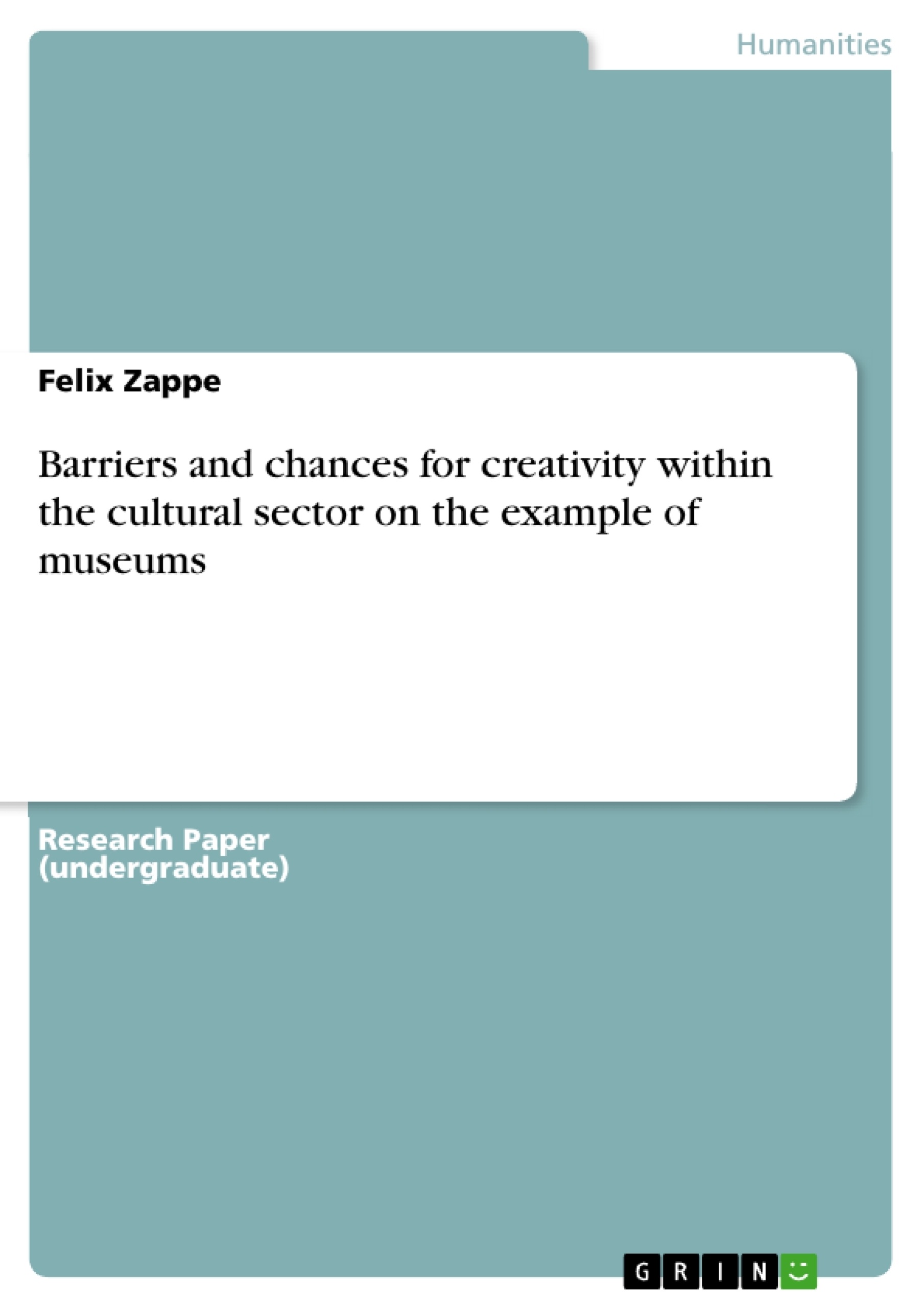The sub-sector of museums within the cultural and creative industries has special potential barriers to creativity and innovation which are described in this work.
Content
Figures
1 Introduction
1.1 Creativity and the creative & cultural industry
2 Innovation and Creativity efforts concerning museums
2.1 Skills
2.2 Network
2.3 Structure
References
Figures
Figure 1: Creative economy and its pillars according to the CEWG (Source: CEWG, 2012, p. 7).
Figure 2: MIM application (Source: Eid, 2016).
Figure 3: Open sourcing as a path for open innovation on the example of an source code (Source: Eid, 2016).
1 Introduction
In this chapter of this work the creative sector will be shortly described as it is understood in the further context.
1.1 Creativity and the creative & cultural industry
Even though creativity and its definition is broadly researched and disputed between scholars (e.g. Runco and Jaeger, 2012) psychologists mostly coincide that the defining properties of creativity are originality and functionality of proposed ideas into a specific topic or regarding a problem (Kersting, 2003).
These characteristics of creativity open up a huge opportunity for economies to regain strength using their creative abilities to venture into new areas and topics within their respective creative industries. For that reason the Maltese government assigned a creative economy working group (CEWG, 2012) to define the creative and cultural sector, describing possible policies and generating steps for a change professional education, networking and market approaches to support this industry.
Abbildung in dieser Leseprobe nicht enthalten
Figure 1: Creative economy and its pillars according to the CEWG (Source: CEWG, 2012, p. 7).
Within the mentioned report the creative and cultural industries (CCI) are defined as those who enable experiences both to be shared and experienced, it is highly knowledge based and combines traditional skills and techniques with modern economic activities and technologies for the sake of wealth generation and job creation (CEWG, 2012, pp. 4-6). The main pillars of the CCI are indicated in figure 1.
2 Innovation and Creativity efforts concerning museums
As shown exemplarily above the museum sector has undergone a lot of changes in the recent years; be it from new communication channels, to new formats and event types up to new competitors or substitute services such as the Google Culture and Arts program or other interactive web-based ways of experiencing culture.
Within this highly competitive environment it can be difficult to maintain the socio-cultural mission of a museum; however scholars have proposed a way of organizing museums market activities to an extent that enables them to achieve their organizational mission more effectively and efficiently. The proposed model is the museum innovation model (MIM) which consists of the three pillars Open innovation, social enterprise and social innovation, being linked by the rational of using open innovation strategies and to accomplish social entrepreneurship business models subsequently enables the museum to practice social innovation (Eid, 2016, see figure 2).
Abbildung in dieser Leseprobe nicht enthalten
Figure 2: MIM application (Source: Eid, 2016).
Of special interest within this context is the application of the two-way innovation path used for two-way open sourcing. This path considers next to the museum as the innovation performing entity the inbound and the outbound perspective. Arguing mostly, that workflows and mostly workers inside the museum while performing their tasks in an open for outside contribution environment, open up possibilities for outside entities to contribute and subsequently enabling all profiting from an overall better product. The outside entities on the other hand can use their gained knowledge to spread new techniques to other museums willing to improve (Eid, 2016; see figure 4).
Abbildung in dieser Leseprobe nicht enthalten
Figure 3: Open sourcing as a path for open innovation on the example of an source code (Source: Eid, 2016).
This model makes clear that there are 3 basic organizational layers that museums should consider when focusing this approach and which contain main threads to this approach:
- The inside of the museum, i.e. the skilled workers or skills within the museum
- The outside of the museum, i.e. the network of a museum
- The museum itself, i.e. the organizational structure of the museum.
[...]
- Citar trabajo
- Felix Zappe (Autor), 2017, Barriers and chances for creativity within the cultural sector on the example of museums, Múnich, GRIN Verlag, https://www.grin.com/document/358281
-

-

-

-
¡Carge sus propios textos! Gane dinero y un iPhone X. -

-
¡Carge sus propios textos! Gane dinero y un iPhone X. -

-
¡Carge sus propios textos! Gane dinero y un iPhone X. -

-
¡Carge sus propios textos! Gane dinero y un iPhone X. -

-
¡Carge sus propios textos! Gane dinero y un iPhone X.

